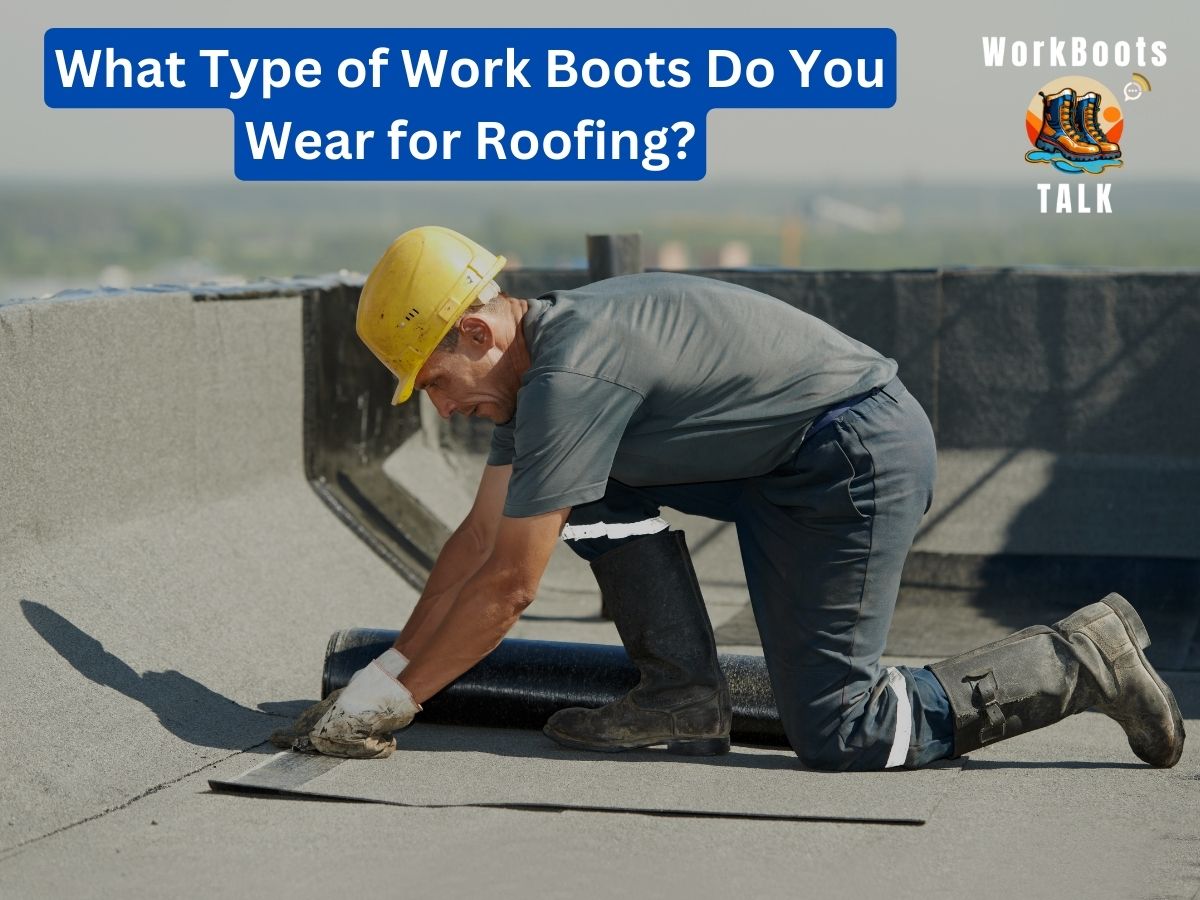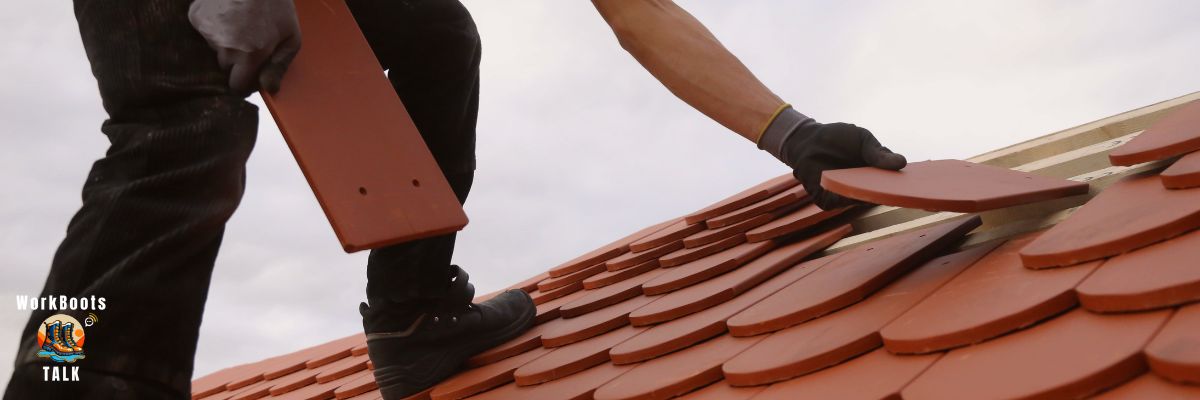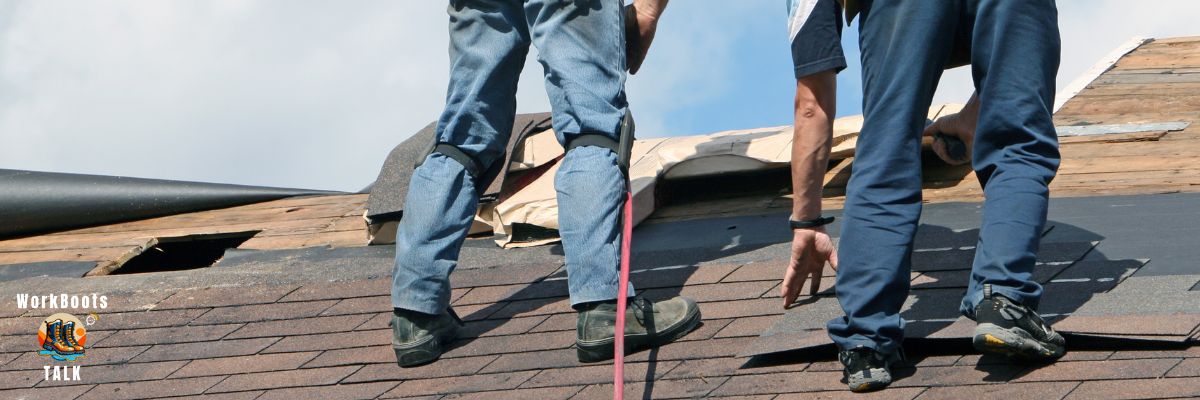As a roofer, selecting the appropriate work boots isn’t just about comfort—it’s a critical choice that impacts your safety, comfort, and effectiveness on the job. With a myriad of options on the market, pinpointing the ideal pair can seem daunting.
Consider this guide your guiding star as you navigate through a vast ocean of choices. We’ll highlight key features to consider and explore top picks that excel in traction, longevity, protection, and style. No matter if your days are spent on asphalt shingles, metal surfaces, or flat roofs, we’re here to help you land on the work boots best suited for your professional demands.
Ready to step up your footwear game? Dive in with us as we explore the best work boots for roofing.
Safety Requirements for Roofing Shoes
Roofing ranks as a high-risk profession, demanding appropriate footwear to fend off injuries and mishaps. As per OSHA guidelines, roofing footwear must shield the feet from hazards such as falling or rolling objects, or sharp items penetrating the sole. Moreover, these shoes should possess certain characteristics that render them adept for work on various roofing surfaces. Below, we delineate the critical safety features recommended for roofing footwear:
Slip Resistance for Steep Roofs
A paramount feature of roofing footwear is its slip resistance. High-quality roofing boots will incorporate shock-absorbing midsoles and a vamp that ensures foot security, while the tread design—often in the form of cleats—will maximize contact with the roof surface to prevent slippage. It’s crucial for roofers to maintain a firm footing, particularly on steep surfaces where the danger of tumbling is significantly escalated.
Attention to the soles’ pattern and its grip properties, which are instrumental in navigating different types of shoes for various roofing materials, can be the difference between a secure step and a hazardous slip. Footwear designed with slip resistance in mind plays a vital role in helping roofers sidestep slips, trips, and falls—prevalent causes of injuries and fatalities within the roofing sector.
Toe Protection from Falling Objects
Toeing another crucial line in safety, roofing shoes must also offer protection against hazards that pose a risk to the roofer’s toes, such as plummeting shingle bundles, tools, or debris. Employing toe caps made from steel, composite materials, or softer alternatives can either prevent or diminish the gravity of such injuries. Steel toe caps stand out for their durability and toughness, albeit being somewhat weighty and a conductor of heat or electricity. Composite toe caps offer a lighter, non-conductive option, though their impact resistance might trail behind steel. Soft toe caps prioritize comfort and flexibility but afford minimal protection. Selection among these options should align with the roofer’s personal preference and the specific roofing task at hand.
Ankle Support for Stability
Ensuring ankle stability constitutes the final cornerstone of safety for roofing footwear. When navigating uneven or inclined surfaces, roofers must count on robust and well-balanced support underfoot. Attaining ankle stability involves the use of high-top boots or shoes that envelop the ankle, coupled with features like straps, laces, or ankle grips to lock the foot in place securely. Such measures not only aid in preserving the roofer’s balance but also mitigate stress exerted on their joints and muscles, ultimately fostering a safer and more efficient work environment.
Choosing the right work boots for roofing involves more than just meeting safety standards. It’s important to consider several factors that influence the performance, comfort, and longevity of your footwear. Below, we’ve outlined crucial elements to keep in mind:
Durability for Tough Conditions
Roofing challenges your work boots with extreme conditions — be it scorching heat, freezing cold, wetness, or constant abrasion. You’ll need boots built to endure these harsh environments and serve you well over time. Durability hinges on both the material and the construction technique. Leather, known for its robust vamp, synthetic materials, and rubber favoured for its insulation qualities, is proven to be tough. The soles should be designed to resist wearing down, complemented by durable shoelaces that withstand the rigors of daily use. For heavier-duty jobs, footwear may feature punk-resistant materials to protect against nails or sharp debris. Methods like welt, cement, and direct attach constructions further reinforce durability, resulting in footwear that not only stands the test of time but also saves you money and inconvenience in the long haul. In extreme weather conditions, the addition of overshoes can provide extra protection against the elements.
Waterproofing for Rainy Conditions
Waterproofing is another critical aspect, especially for roofers who often face rain or moist conditions. Damp feet are not just uncomfortable; they can lead to blisters, infections, or even frostbite in colder weather. Opting for waterproof or water-resistant boots can keep your feet dry and safeguard your comfort and health. This protective feature is typically achieved with materials like leather, rubber, or advanced fabrics like Gore-Tex, or through additional waterproof coatings or sprays.
Breathability for Comfort in Various Weather Conditions
Lastly, don’t overlook the importance of breathability. Working on roofs means exposure to all sorts of weather, from sweltering heat to bone-chilling winds. To manage foot temperature and moisture, breathable work boots are essential. This feature often depends on both the materials (such as mesh, nylon, or cotton) and the design (including vents, perforations, or moisture-wicking linings). Breathable boots ensure that your feet stay comfortable, no matter the weather conditions.
Top 5 Work Boots for Roofing
Cougar Paws Peak Series Performer Roofer Boots
- Designed specifically for roofers, these boots come with groundbreaking traction grip technology that ensures stability and safety on steep surfaces.
- They feature a soft leather upper, a breathable lining for maximum comfort, and thermal protection to keep your feet cool.
- With a removable cushioned insole and a heat, oil, slip, and abrasion-resistant rubber outsole, these boots are perfect for offering both high performance and comfort during roofing projects.
Timberland PRO Men’s Wedge Sole 6″ Boot
- A perfect pick for workers seeking a versatile and dependable boot, this option boasts a waterproof, full-grain leather upper, coupled with a padded collar for enhanced comfort and support.
- The inclusion of a steel shank and a nylon shock-diffusion plate offers structural support and minimizes foot fatigue.
- Its rubber outsole, resistant to oil, slip, and abrasion, features a wedge heel designed to provide improved grip on uneven terrains, making these boots ideal for construction, loading docks, and other manual labour tasks.
Carhartt Men’s 6 Inch Waterproof Wedge Soft Toe Work Boot
- Merging style with functionality, these boots feature a high-quality, waterproof and breathable leather upper, along with a moisture-wicking mesh lining that keeps odours at bay.
- The cushioned insole offers excellent shock absorption and energy return, while the ExoSpine technology enhances both durability and heel fit.
- The rubber outsole, resistant to heat, oil, slip, and abrasion and designed with a wedge, improves traction and stability.
- These boots are a great choice for anyone working on their feet, providing both comfort and protection.
WOLVERINE Men’s Moc Toe 6″ Construction Boot
- A durable and comfortable choice for the job site, these boots feature an oil-tanned, waterproof leather upper and a Goodyear welt construction for longevity and the possibility of being resolved.
- Additionally, a removable full-cushion footbed, rubber midsole, and nylon shank offer extra comfort and support.
- The crepe rubber outsole is flexible and slip-resistant, and the moc toe style adds a casual appearance.
- These boots are fit for industrial, construction, and manufacturing environments, guaranteeing long-lasting wear and comfort.
Vans Men’s Low-top Sneaker (for Light, Dry Conditions)
- Ideal for roofers who find themselves working in lighter, drier environments, these sneakers blend casual comfort with practical functionality.
- Crafted with a breathable canvas upper that’s straightforward to maintain, their lace-up design secures a perfect fit around your feet.
- Comfort is further assured with a padded collar and a cushioned footbed, ensuring both support and comfort throughout the wear.
- Their durability and flexibility are significantly boosted by a vulcanized construction.
- Meanwhile, the rubber outsole features a unique waffle pattern, providing reliable grip across a variety of surfaces.
- Beyond roofing, these sneakers are equally suitable for skateboarding, making them a versatile addition to your wardrobe.
Maintenance and Care
Cleaning and Waterproofing Tips:
- Regularly clean your boots by wiping off dirt and debris.
- Use a soft brush or damp cloth to remove stains.
- Use a waterproof spray to shield against moisture.
Extending the Lifespan of Roofing Work Boots:
- Rotate between multiple pairs to reduce wear on any single pair.
- Keep your boots in a cool and dry spot, steering clear of direct sunlight.
- Swap out worn insoles to enhance both comfort and support.
Recognizing Signs of Wear and Tear:
- Check for sole wear, cracks, or loose stitching.
- Inspect the toe area for damage.
- If you notice significant wear, consider replacing your boots.
Remember, proper care ensures your work boots stay reliable and comfortable throughout your roofing projects!
Conclusion:
Roofing presents unique challenges and hazards, necessitating the use of appropriate work boots. Through this discussion, we’ve covered essential safety protocols, critical considerations, and our top five recommendations for roofing work boots. We aim to assist you in selecting the ideal work boots for your specific roofing requirements.
It’s crucial to understand that the right footwear not only enhances your safety but also your comfort and efficiency while working on roofs. Thus, settling for anything but the optimal choice is not advisable. Ensure you pick work boots that align with your roofing material, personal tastes, and budget. Additionally, maintaining your work boots in prime condition is essential for the longevity of both the boots and the protection they offer your feet.
Armed with knowledge about which work boots are best for roofing, we encourage you to explore the recommendations we’ve provided. These selections are available on Amazon, where you can easily compare prices, sift through reviews, and benefit from hassle-free shipping. Follow the links provided below to find and purchase your next pair of work boots effortlessly.
Frequently Asked Questions
1. What boots are good for roofing?
Quality work boots with slip-resistant soles, ankle support, and toe protection are ideal for roofing. Brands like Red Wing, Timberland, and Wolverine are popular choices.
2. What are the boots on a roof?
The best boots on a roof are those designed for roofing work. They should have features like slip-resistance, ankle support, and durability to navigate the challenges of uneven surfaces.
3. What shoes are good for metal roofing?
For metal roofing, choose boots with excellent traction and stability. Athletic-style roofing boots with slip-resistant soles are often recommended for working on metal surfaces.
4.What shoes are best for working on roofs?
The best shoes for working on roofs are those with slip-resistant soles, ankle support, and durability. Look for features that enhance safety and comfort during roofing tasks.
5. What do roofers wear on their feet?
Roofers typically wear specialized work boots designed for the job. These boots provide safety features such as slip-resistance, ankle support, and toe protection.
6. How much do roofing boots cost?
The cost of roofing boots varies depending on the brand and features. On average, quality roofing boots can range from $80 to $200, with higher-end brands and additional features affecting the price.
7. What kind of shoes do roofers wear on metal roofs?
Roofers working on metal roofs often opt for boots with slip-resistant soles, providing the necessary grip on the smooth surfaces of metal roofing. Athletic-style roofing boots are a popular choice.
8. Are Keen boots good for roofing?
Yes, Keen boots are generally well-regarded for roofing. Look for models with slip-resistant soles, good ankle support, and durability, as these are crucial features for roofing work.
9. How do roofers walk on steep roofs?
Roofers walk on steep roofs using specialized roofing boots with excellent traction. These boots, combined with proper techniques and safety equipment, enable roofers to navigate steep slopes safely.
10. How do roofing boots work?
Roofing boots work by providing essential features for the job, including slip-resistant soles for traction, ankle support for stability, and toe protection. These features ensure safety and comfort during roofing tasks.



